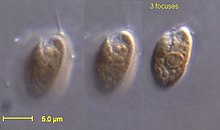| Rhodomonas | |
|---|---|

| |
| Rhodomonas salina | |
| Scientific classification | |
| Domain: | |
| Phylum: | |
| Class: | |
| Order: | |
| Family: | |
| Genus: | Rhodomonas Karsten 1898
|
| Type species | |
| Rhodomonas baltica Karsten 1898
| |
| Synonyms | |
| |
Rhodomonas is a genus of cryptomonads.[1][2] It is characterized by its red colour, the square-shaped plates of its inner periplast, its short furrow ending in a gullet, and a distinctly shaped chloroplast closely associated with its nucleomorph.[3] Historically, Rhodomonas was characterized by its red chloroplast alone,[4] but this no longer occurs as its taxonomy has become increasingly based on molecular and cellular data.[5][6] Currently, there is some debate about the taxonomic validity of Rhodomonas as a genus and further research is needed to verify its taxonomic status.[4][7] Rhodomonas is typically found in marine environments, although freshwater reports exist.[4] It is commonly used as a live feed for various aquaculture species.[8]
- ^ Khan H, Parks N, Kozera C, et al. (August 2007). "Plastid genome sequence of the cryptophyte alga Rhodomonas salina CCMP1319: lateral transfer of putative DNA replication machinery and a test of chromist plastid phylogeny". Mol. Biol. Evol. 24 (8): 1832–42. doi:10.1093/molbev/msm101. PMID 17522086.
- ^ Becker M, Stubbs MT, Huber R (March 1998). "Crystallization of phycoerythrin 545 of Rhodomonas lens using detergents and unusual additives". Protein Sci. 7 (3): 580–6. doi:10.1002/pro.5560070306. PMC 2143966. PMID 9541389.
- ^ Kugrens, Paul; Clay, Brec L.; Lee, Robert E. (1999). "Ultrastructure and Systematics of Two New Freshwater Red Cryptomonads, Storeatula Rhinosa, Sp. Nov. And Pyrenomonas Ovalis, Sp. Nov". Journal of Phycology. 35 (5): 1079–1089. doi:10.1046/j.1529-8817.1999.3551079.x. ISSN 0022-3646. S2CID 83581600.
- ^ a b c Hill, David R. A.; Wetherbee, Richard (1989). "A reappraisal of the genus Rhodomonas (Cryptophyceae)". Phycologia. 28 (2): 143–158. doi:10.2216/i0031-8884-28-2-143.1. ISSN 0031-8884.
- ^ Erata, Mayumi; Chihara, Mitsuo (1989). "Re-examination ofPyrenomonas andRhodomonas (class cryptophyceae) through ultrastructural survey of red pigmented cryptomonads". The Botanical Magazine Tokyo. 102 (3): 429–443. doi:10.1007/BF02488125. ISSN 0006-808X. S2CID 42480798.
- ^ Santore, U. J. (1984). "Some Aspects of Txonomy in the Cryptophyceae". New Phytologist. 98 (4): 627–646. doi:10.1111/j.1469-8137.1984.tb04153.x. ISSN 0028-646X.
- ^ Current advances in algal taxonomy and its applications : phylogenetic, ecological and applied perspective. Konrad Wołowski, Instytut Botaniki im. W. Szafera. Krakow: W. Szafer Institute of Botany, Polish Academy of Sciences. 2012. pp. 15–52. ISBN 978-83-62975-03-7. OCLC 799029033.
{{cite book}}: CS1 maint: others (link) - ^ Latsos, Christos; van Houcke, Jasper; Blommaert, Lander; Verbeeke, Gabrielle P.; Kromkamp, Jacco; Timmermans, Klaas R. (2021). "Effect of light quality and quantity on productivity and phycoerythrin concentration in the cryptophyte Rhodomonas sp". Journal of Applied Phycology. 33 (2): 729–741. doi:10.1007/s10811-020-02338-3. ISSN 0921-8971. S2CID 230795287.